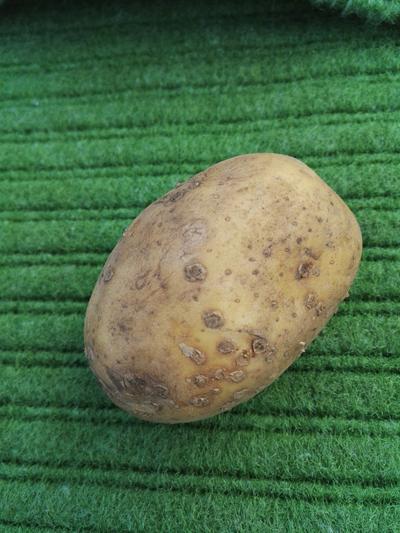Powdery Scab
Spongospora subterranea
Fungus
In a Nutshell
- Small dark round lesions of shallow depressions surrounded by raised torn edges of ruptured skin.
- Where large areas are affected, they tend to appear as grouped individuals.
Can also be found in
Symptoms
There are no above ground manifestations. Initial symptoms on potato tubers are small, slightly raised, purplish-brown pustules, circular in shape and smooth and spongy in appearance. As they increase in size, they coalesce and form large, irregular lesions on the potato skin. They later burst, rupturing the skin of the potato tuber and forming corky shallow cankers known as scab. Swellings, galls or warts develop, deforming the potatoes significantly and making them unmarketable. In high moisture soils, lesions expand inwards, forming deep pits and destroying a large portion of internal tissues. The anomalies may continue to grow during storage.
Recommendations

Organic Control
No alternative treatment against this pathogen is available, so be sure to apply preventive measures.

Chemical Control
Always consider an integrated approach with preventive measures together with biological treatments if available. Drenching of soils with metam sodium or fluazinam work well in some cases, mostly depending on the environmental conditions and the type of soil.
What caused it?
Powdery scab is caused by a soil borne pathogen (Spongospora subterranea) that can survive up to 6 years in soils. The disease is common in cool temperatures (12 to 18°C) and heavy, acidic soils, that are prone to water-logging. Alternating periods of wet and dry weather can also favor its development. Infected seed tubers, clothing, tools or manure can be carriers of the pathogen. The infection happens at tuber initiation through the lenticels, eyes or wounds of the tubers. Russet potato varieties are somwhat more tolerant to this disease and show fewer symptoms of damage. Powdery scab can infect several members of the solanaceous family, for example tomato.
Preventive Measures
- Check with seed retailer on resilient varieties.
- Use healthy seeding material from certified sources.
- Implement a well-coordinated crop rotation.
- Plant in well-drained soils that are not susceptible to water-logging.
- Check for alternative hosts of the solanaceous family in and around the field and eradicate them.
- Apply sulfur to your soils to control pH.
- Take special care of the disinfection of your equipment, clothes and tools.
- Do not apply manure from animals that have been fed scabby potatoes.
- Deep plow and soil solarization after harvest also help.



